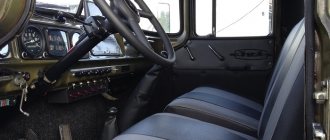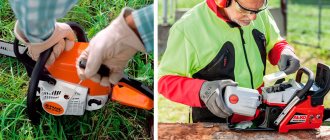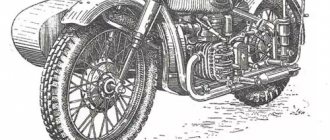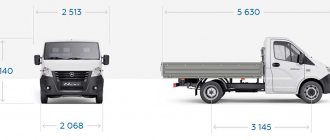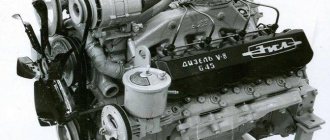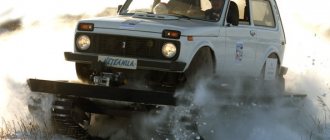Many, many years ago
The story begins in Yaroslavl. In 1938, the local automobile plant produced experimental vehicles of a new family - the YAG-7 flatbed truck and the YAS-4 dump truck based on it, which were planned to be produced from 1942 after the reconstruction of the plant. Despite the lack of a suitable engine (the ZiS-16 petrol engine with an output of 82 hp was temporarily chosen), the cars were made at a high technical level for those years.
Experimental dump truck YAS-4, 1938
The production of new cars was prevented by the war. The plant returned to the development of civilian equipment only in 1943. In December 1944, the OK-200 car was built, retaining some of the developments from the YAG-7, but equipped with an American GMC 4-71 diesel engine, the decision to license production of which under the YAZ-204 brand was made before the war. In order to speed up production, the cabin and a number of other components were taken from a Mack truck supplied to the USSR under Lend-Lease.
Having passed the tests and received a simplified wood-metal cabin, the car went into mass production under the YAZ-200 brand in 1947.
Experimental OK-200 (YAZ-200), December 1944
In the same year, on the basis of the YAZ-200, the YAZ-205 dump truck was produced, the production of which was transferred to the newly created Minsk Automobile Plant.
YaAZ-205, 1947
MAZ-205 is a legendary car; almost 100 thousand of them were produced over 18 years of production (1947-1965). Until the mid-1950s, this vehicle was the only large-scale heavy dump truck and made a huge contribution to the restoration and development of the USSR after the war, performing hard work on almost all the country’s landmark construction sites. This could not but affect the safety of the cars - there were at most a dozen of them left.
Specifications
During the production of the 200 model, innovations began to be introduced into the Soviet automobile industry. Thus, already in the forties, synchronizers began to be installed in gearboxes. This element, as is already known, provided smoother switching between stages. An even rarer element appeared on the dashboard - a tachometer. In those days, this sensor was extremely rare.
Engine and cabin. Initially, the propulsion system of the MAZ-200 was similar to one of the American ones, but later in Yaroslavl they developed their own version, the YaAZ-204 (later 200). After the developers were convinced of the consistently high results of the machine, it was decided to modify the model for military needs. During the conversion process, the engine became more powerful, now 120 horses, high sides of the cargo bed, folding benches and guides for the awning. The functionality was supplemented by a winch at the rear of the car. Thanks to it, the tractor could pull a load weighing up to ten tons.
But they didn’t stop developing the basic version either. Within a few years the cabin was improved. Since the stamping process was just developing, making a cabin from wood was a rather long and labor-intensive process. Subsequently, the cabin was made of individual elements, similar to what is happening now.
Brake system. A pneumatic system that operates using a receiver and compressor from the engine compartment. It often happened that the brakes failed, in which case the probability of an accident became almost 100% (the car was almost without control). Because of this, the brakes have been redesigned.
The handbrake held the crankshaft flywheel with the help of “shoes”. Popularly it was often referred to as “emergency” and was regulated by a lever to the right of the steering wheel. All four wheels were equipped with drum brakes with adjustable pads.
Chassis and steering. Steering mechanism type – worm-sector. Gear ratio – 21.5. The suspension is equipped with springs, supplemented by shock absorbers (at the rear); the rear part was similar, only supplemented with reinforcing doublers.
Scars and more
The car being restored is in overall good condition. The car, produced in 1959, was quite complete, but the overall condition was unimportant. Several teams worked on the car. Behind our small team there was a dump platform with a subframe.
Interestingly, the platform has its own history. The design of a box platform with a manual side locking drive and a hydraulic lifting mechanism was proposed by the American company GAR Wood Industries in the 1920s. Having once become widespread in the United States, this design, with some modifications, is still used today.
In the USSR, the first dump trucks with such a platform design appeared in 1934 (ZiS-19), but did not become widespread before the war. Mass production of such dump trucks began already in the post-war years (ZiS-05, GAZ-93, MAZ).
ZiS-05
They all had similar box-shaped all-metal bodies with flat sides, reinforced with buttress ribs. The tailgate could be hinged on top or bottom hinges. The side was unlocked manually using a lever on the front wall of the platform on the driver's side. The lever moved the lock through the rod, securing the side.
It is worth saying that such a universal platform was not well suited for the main specialization of the MAZ-205 in the 1950s - working in a quarry, transporting stones and rubble. Therefore, they were often altered during operation, digesting and strengthening.
So our “patient” had numerous scars from the repairs he had undergone. There was not a single level element on the platform. And almost nothing remained of the “original” structure, only a bent base here and there and chewed side reinforcements-buttresses. The “original” tailgate was completely lost, as was its locking mechanism. Instead, another one was home-made with a completely different fastening. Almost all the fittings were missing, as well as the platform support. There is nothing to restore here - you need to make a new one.
Platform on a car. The non-original tailgate is clearly visible
The platform has been removed. The buttress ribs on the sides are the only visible “original” elements
Condition of subframe elements
Modifications
The heavy dump truck had 2 modifications:
- MAZ-205B. This is a dump truck, which differs from the basic one in having a bucket-shaped body. Appeared in 1952. Not serially produced.
- MAZ-506. The model is a dump truck with side unloading. It was created in 1954. It did not go into series.
As a base car, it was used by various organizations in developments to create:
- dump truck with unloading on both sides;
- a vehicle for transporting the solution;
- rotary snow blower;
- tank trucks ATs-40, 45, 30 with a water capacity of 5 thousand m³ and a combat crew of 3 people;
- hose vehicle for fire-fighting purposes;
- an army truck equipped with an awning;
- fuel tankers;
- truck tractors;
- truck crane.
Modifications of the MAZ-205 bus differ from the base vehicle:
- the presence of a fifth door intended only for the driver;
- equipped with Mercedes engines that meet Euro 3 and 5.
No hack work
But what platform should we make? You can follow the simple path and make something vaguely similar to the “native” layout. However, this is a clear disrespect for the veteran, and this approach is not typical for me and my colleagues. It also played a role that each of us at one time worked at a car plant for several years. Therefore, the opportunity to have a hand in his story warmed the soul; we could not afford to cheat in such a matter. It was decided to make a platform with minimal deviations from the original. All that remains is to find the original.
We started by searching for literature on the car and drawings. The literature was found quickly - in the library of the car plant. Also a kind of museum copies - the oldest book from 1949.
Literature on the car
It was more difficult with the drawings. They were not found at MAZ - all documentation was transferred to the state archives. There we were only able to obtain assembly drawings of the platform, subframe and installation of the tailgate. Only 5 drawings out of almost a hundred needed. Of course, if we sat in the archives with a parts catalog, asking for documentation on serial numbers, perhaps we would find something else. But this is very time-consuming, and we have limited deadlines.
The source of the missing information was the only 100% original MAZ-205 that has survived to this day - the one on the pedestal at the central entrance of the plant. It’s worth saying that you can’t just climb in there and take measurements. After all, the Minsk Automobile Plant is a sensitive facility. We contacted the plant management and received permission to work. From that moment on, a stepladder and every conceivable measuring tool lived in my car for a month. There were many approaches to the monument. As the design documentation was developed, we constantly had to clarify something with the “original source”.
Taking measurements on the monument and the remains of the old platform from the car being restored, checking with literature and archival drawings, after some time we received a complete three-dimensional model of the platform and subframe.
Design and production was an exciting challenge for everyone involved. Since some of the parts of the original platform were made by casting and stamping (which was due to mass production), we had to, while maintaining the shape and appearance of the parts, adapt the design to the existing technological capabilities. A few examples are in the photo below.
Tailgate hinge and locking mechanism hinge. Parts made of 6mm deep drawn steel. This cannot be repeated on a conventional press brake.
Blanks cut from pipe 100x80x6
Parts prepared for welding
Tailgate release lever. Fitting on the new platform and the same on the original car. The original has one cast part. The new one has a seven-piece welded structure
The final welding was carried out with a large weld leg, simulating casting radii
An excerpt characterizing the MAZ-205 (truck)
While Prince Andrei met with Nesvitsky and Zherkov, on the other side of the corridor, Strauch, an Austrian general who was at Kutuzov’s headquarters to monitor the food supply of the Russian army, and a member of the Gofkriegsrat, who had arrived the day before, walked towards them. There was enough space along the wide corridor for the generals to freely disperse with three officers; but Zherkov, pushing Nesvitsky away with his hand, said in a breathless voice: “They’re coming!... they’re coming!... step aside, get out of the way!” please the way! The generals passed by with an air of desire to get rid of bothersome honors. The face of the joker Zherkov suddenly expressed a stupid smile of joy, which he seemed unable to contain. “Your Excellency,” he said in German, moving forward and addressing the Austrian general. – I have the honor to congratulate you. He bowed his head and awkwardly, like children learning to dance, began to shuffle first with one foot and then with the other. The general, a member of the Gofkriegsrat, looked sternly at him; without noticing the seriousness of the stupid smile, he could not refuse a moment’s attention. He narrowed his eyes to show that he was listening. “I have the honor to congratulate you, General Mack has arrived, he’s completely healthy, he just got a little sick,” he added, beaming with a smile and pointing to his head. The general frowned, turned away and walked on. – Gott, wie naiv! [My God, how simple it is!] - he said angrily, walking away a few steps. Nesvitsky hugged Prince Andrei with laughter, but Bolkonsky, turning even paler, with an angry expression on his face, pushed him away and turned to Zherkov. The nervous irritation into which the sight of Mack, the news of his defeat and the thought of what awaited the Russian army led him, found its outcome in anger at Zherkov’s inappropriate joke. “If you, dear sir,” he spoke shrilly with a slight trembling of his lower jaw, “want to be a jester, then I cannot prevent you from doing so; but I declare to you that if you dare to make fun of me in my presence another time, then I will teach you how to behave. Nesvitsky and Zherkov were so surprised by this outburst that they silently looked at Bolkonsky with their eyes open. “Well, I just congratulated,” said Zherkov. – I’m not joking with you, please remain silent! - Bolkonsky shouted and, taking Nesvitsky by the hand, walked away from Zherkov, who could not find what to answer. “Well, what are you talking about, brother,” Nesvitsky said calmingly. - Like what? - Prince Andrei spoke, stopping from excitement. - Yes, you must understand that we are either officers who serve our tsar and fatherland and rejoice in the common success and are sad about the common failure, or we are lackeys who do not care about the master’s business. Quarante milles hommes massacres et l'ario mee de nos allies detruite, et vous trouvez la le mot pour rire,” he said, as if cementing his opinion with this French phrase. - C'est bien pour un garcon de rien, comme cet individu, dont vous avez fait un ami, mais pas pour vous, pas pour vous. [Forty thousand people died and the army allied to us was destroyed, and you can joke about it. This is forgivable for an insignificant boy like this gentleman whom you made your friend, but not for you, not for you.] Boys can only have fun like this,” said Prince Andrei in Russian, pronouncing this word with a French accent, noting that Zherkov could still hear him. He waited to see if the cornet would answer. But the cornet turned and left the corridor. The Pavlograd Hussar Regiment was stationed two miles from Braunau. The squadron, in which Nikolai Rostov served as a cadet, was located in the German village of Salzenek. The squadron commander, captain Denisov, known throughout the cavalry division under the name Vaska Denisov, was allocated the best apartment in the village. Junker Rostov, ever since he caught up with the regiment in Poland, lived with the squadron commander. On October 11, the very day when everything in the main apartment was raised to its feet by the news of Mack's defeat, at the squadron headquarters, camp life calmly went on as before. Denisov, who had lost all night at cards, had not yet come home when Rostov returned from foraging early in the morning on horseback. Rostov, in a cadet's uniform, rode up to the porch, pushed his horse, threw off his leg with a flexible, youthful gesture, stood on the stirrup, as if not wanting to part with the horse, finally jumped off and shouted to the messenger. “Ah, Bondarenko, dear friend,” he said to the hussar who rushed headlong towards his horse. “Lead me out, my friend,” he said with that brotherly, cheerful tenderness with which good young people treat everyone when they are happy. “I’m listening, your Excellency,” answered the Little Russian, shaking his head cheerfully. - Look, take it out well! Another hussar also rushed to the horse, but Bondarenko had already thrown over the reins of the bit. It was obvious that the cadet spent a lot of money on vodka, and that it was profitable to serve him. Rostov stroked the horse’s neck, then its rump, and stopped on the porch. “Nice! This will be the horse!” he said to himself and, smiling and holding his saber, ran up onto the porch, rattling his spurs. The German owner, in a sweatshirt and cap, with a pitchfork with which he was clearing out manure, looked out of the barn. The German's face suddenly brightened as soon as he saw Rostov. He smiled cheerfully and winked: “Schon, gut Morgen!” Schon, gut Morgen! [Wonderful, good morning!] he repeated, apparently finding pleasure in greeting the young man. - Schon fleissig! [Already at work!] - said Rostov with the same joyful, brotherly smile that never left his animated face. - Hoch Oestreicher! Hoch Russen! Kaiser Alexander hoch! [Hurray Austrians! Hurray Russians! Emperor Alexander, hurray!] - he turned to the German, repeating the words often spoken by the German owner. The German laughed, walked completely out of the barn door, pulled off his cap and, waving it over his head, shouted: “Und die ganze Welt hoch!” [And the whole world hurray!] Rostov himself, just like a German, waved his cap over his head and, laughing, shouted: “Und Vivat die ganze Welt”! Although there was no reason for special joy either for the German, who was cleaning out his barn, or for Rostov, who was riding with his platoon for hay, both these people looked at each other with happy delight and brotherly love, shook their heads as a sign of mutual love and parted smiling - the German to the cowshed, and Rostov to the hut he occupied with Denisov. - What is it, master? - he asked Lavrushka, Denisov’s lackey, a rogue known to the entire regiment. - Haven't been since last night. That’s right, we lost,” Lavrushka answered. “I already know that if they win, they’ll come early to brag, but if they don’t win until morning, that means they’ve lost their minds, and they’ll come angry.” Would you like some coffee? - Come on, come on. After 10 minutes, Lavrushka brought coffee. They're coming! - he said, - now there’s trouble. - Rostov looked out the window and saw Denisov returning home. Denisov was a small man with a red face, shiny black eyes, and black tousled mustache and hair. He had an unbuttoned mantle, wide chikchirs lowered in folds, and a crumpled hussar cap on the back of his head. He gloomily, with his head down, approached the porch.
What happened?
Of course, not everything was reproduced accurately. For example, it is now impossible to find 7 mm steel for subframe parts; the stopper chains and tailgate chain are slightly different from the original ones. Some thin-walled parts are made of galvanized steel for durability. But in general, it turned out “like a native” platform from the 1950s-1960s, made a little carelessly, due to the mass production and technology of those years.
Design and production took approximately two and a half months. We finished it already during the pandemic and quarantine. All involved were pleased with the result. Later, we managed to restore the hydraulics on the vehicle, so the dump truck is quite functional - even use it for a construction site. But it seems to us that over the long and difficult years of his life he deserved a rest.
Competition partners:
WESTMOTORS company – selection and delivery without intermediaries of cars and equipment from the USA, Europe, Canada and China.
Bir.by - smart real estate search for new buildings in Minsk
